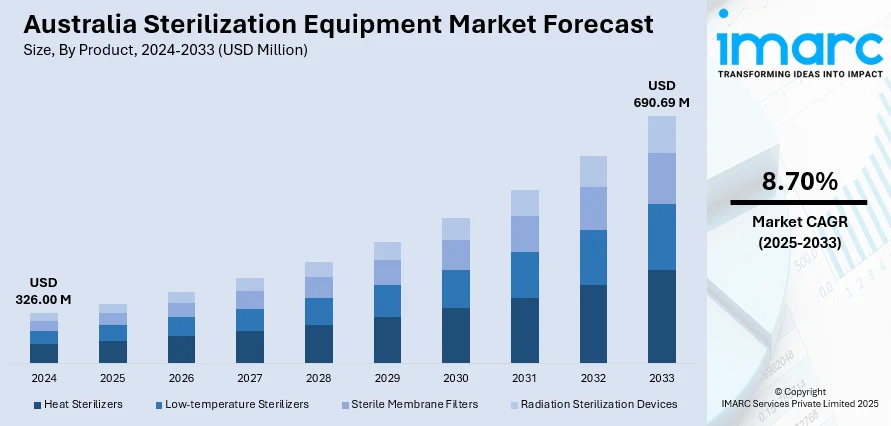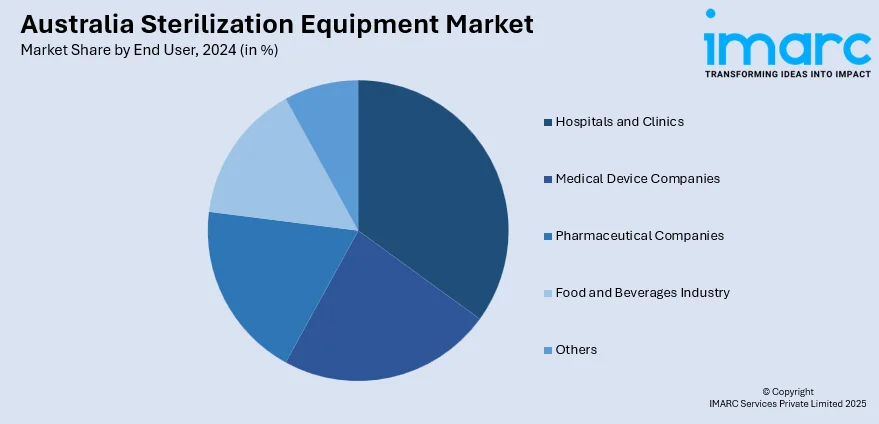
Australia Sterilization Equipment Market Size, Share, Trends and Forecast by Product, End User, and Region, 2025-2033
Australia Sterilization Equipment Market Overview:
The Australia sterilization equipment market size reached USD 326.00 Million in 2024. Looking forward, IMARC Group expects the market to reach USD 690.69 Million by 2033, exhibiting a growth rate (CAGR) of 8.70% during 2025-2033. The market is growing due to rising demand for real-time monitoring and automated control across sectors such as energy, water treatment, and manufacturing. The Australia sterilization equipment market share is expanding steadily, supported by ongoing infrastructure upgrades and the increasing integration of renewable energy systems into core industrial operations..
|
Report Attribute
|
Key Statistics
|
|---|---|
|
Base Year
|
2024 |
|
Forecast Years
|
2025-2033
|
|
Historical Years
|
2019-2024
|
| Market Size in 2024 | USD 326.00 Million |
| Market Forecast in 2033 | USD 690.69 Million |
| Market Growth Rate 2025-2033 | 8.70% |
Australia Sterilization Equipment Market Trends:
Rising Healthcare Demand Drives Growth
The demand for sterilization equipment in Australia is steadily increasing, largely driven by the growing focus on infection prevention across hospitals and clinics. The healthcare system in Australia has seen significant pressure to improve patient safety, especially after recent global health concerns. This has led to greater investments in maintaining clean and sterile environments. Sterilization equipment, such as autoclaves and low-temperature sterilizers, is being adopted more widely in both public and private healthcare facilities. Additionally, an aging population and rising surgical procedures have further increased the need for effective sterilization practices. Medical professionals are now more aware of hospital-acquired infections and are turning to advanced sterilization solutions as a preventive measure. In the lower half of the market, newer technologies such as hydrogen peroxide plasma sterilizers and UV-based systems are being introduced. These systems provide faster and more efficient sterilization, aligning with hospitals’ need to manage high patient turnover. Government programs supporting health infrastructure development are also positively influencing demand. Overall, the Australia sterilization equipment market growth is expected to surge owing to healthcare regulations and rising awareness.

To get more information on this market, Request Sample
Technological Innovation Enhancing Efficiency
Technological innovation is playing a key role in transforming sterilization practices across Australia's healthcare sector. Traditional methods are being replaced by advanced, automated systems that help streamline operations and minimize human error. Modern equipment now includes features like digital interfaces, real-time system tracking, and automated sterilization cycles, which are especially beneficial for high-volume facilities such as hospitals and diagnostic laboratories. The pursuit of stringent safety and quality standards is encouraging more institutions to invest in these updated technologies. There has also been growing interest in environmentally conscious sterilizers that conserve water and energy, aligning with the country’s broader sustainability goals. Smaller clinics and remote health centers are gaining access to care through compact, mobile sterilization units. Additionally, smart systems with remote access and data logging capabilities are starting to shape future practices by improving maintenance schedules and minimizing equipment downtime. These developments are driving demand across the sector and supporting the expansion of Australia’s sterilization equipment market.
Australia Sterilization Equipment Market Segmentation:
IMARC Group provides an analysis of the key trends in each segment of the market, along with forecasts at the country and regional level for 2025-2033. Our report has categorized the market based on product and end user.
Product Insights:
- Heat Sterilizers
- Depyrogenation Oven
- Steam Autoclaves
- Low-temperature Sterilizers
- Ethylene Oxide Sterilizers
- Hydrogen Peroxide Sterilizers
- Others
- Sterile Membrane Filters
- Radiation Sterilization Devices
- Electron Beams
- Gamma Rays
- Others
The report has provided a detailed breakup and analysis of the market based on the product. This includes heat sterilizers (depyrogenation oven and steam autoclaves), low-temperature sterilizers (ethylene oxide sterilizers, hydrogen peroxide sterilizers, and others), sterile membrane filters, and radiation sterilization devices (electron beams, gamma rays, and others).
End User Insights:

- Hospitals and Clinics
- Medical Device Companies
- Pharmaceutical Companies
- Food and Beverages Industry
- Others
As per Australia sterilization equipment market outlook, a detailed breakup and analysis of the market based on the end user have also been provided in the report. This includes hospitals and clinics, medical device companies, pharmaceutical companies, food and beverages industry, and others.
Regional Insights:
- Australia Capital Territory & New South Wales
- Victoria & Tasmania
- Queensland
- Northern Territory & Southern Australia
- Western Australia
The report has also provided a comprehensive analysis of all the major regional markets, which include Australia Capital Territory & New South Wales, Victoria & Tasmania, Queensland, Northern Territory & Southern Australia, and Western Australia.
Competitive Landscape:
The market research report has also provided a comprehensive analysis of the competitive landscape. Competitive analysis such as market structure, key player positioning, top winning strategies, competitive dashboard, and company evaluation quadrant has been covered in the report. Also, detailed profiles of all major companies have been provided.
Australia Sterilization Equipment Market News:
- September 2024: Olympus Australia launched "Sapphire," its first flexible endoscope sterilisation facility in Melbourne. This milestone enhanced sterilization equipment repair capabilities by streamlining reprocessing services, reducing hospital workload, and increasing access to sterile, ready-to-use endoscopes—boosting demand and reliability in Australia's sterilization equipment market.
- March 2024: Getinge launched the Poladus 150 in Australia, advancing low-temperature sterilization with VH₂O₂ technology. Its cross-contamination barrier and traceability tools improved infection control. This innovation spurred demand for advanced sterilization equipment repair services, boosting growth in Australia sterilization equipment market.
Australia Sterilization Equipment Market Report Coverage:
| Report Features | Details |
|---|---|
| Base Year of the Analysis | 2024 |
| Historical Period | 2019-2024 |
| Forecast Period | 2025-2033 |
| Units | Million USD |
| Scope of the Report |
Exploration of Historical Trends and Market Outlook, Industry Catalysts and Challenges, Segment-Wise Historical and Future Market Assessment:
|
| Products Covered |
|
| End Users Covered | Hospitals and Clinics, Medical Device Companies, Pharmaceutical Companies, Food and Beverages Industry, Others |
| Regions Covered | Australia Capital Territory & New South Wales, Victoria & Tasmania, Queensland, Northern Territory & Southern Australia, Western Australia |
| Customization Scope | 10% Free Customization |
| Post-Sale Analyst Support | 10-12 Weeks |
| Delivery Format | PDF and Excel through Email (We can also provide the editable version of the report in PPT/Word format on special request) |
Key Questions Answered in This Report:
- How has the Australia sterilization equipment market performed so far and how will it perform in the coming years?
- What is the breakup of the Australia sterilization equipment market on the basis of product?
- What is the breakup of the Australia sterilization equipment market on the basis of end user?
- What is the breakup of the Australia sterilization equipment market on the basis of region?
- What are the various stages in the value chain of the Australia sterilization equipment market?
- What are the key driving factors and challenges in the Australia sterilization equipment market?
- What is the structure of the Australia sterilization equipment market and who are the key players?
- What is the degree of competition in the Australia sterilization equipment market?
Key Benefits for Stakeholders:
- IMARC’s industry report offers a comprehensive quantitative analysis of various market segments, historical and current market trends, market forecasts, and dynamics of the Australia sterilization equipment market from 2019-2033.
- The research report provides the latest information on the market drivers, challenges, and opportunities in the Australia sterilization equipment market.
- Porter's five forces analysis assist stakeholders in assessing the impact of new entrants, competitive rivalry, supplier power, buyer power, and the threat of substitution. It helps stakeholders to analyze the level of competition within the Australia sterilization equipment industry and its attractiveness.
- Competitive landscape allows stakeholders to understand their competitive environment and provides an insight into the current positions of key players in the market.
Need more help?
- Speak to our experienced analysts for insights on the current market scenarios.
- Include additional segments and countries to customize the report as per your requirement.
- Gain an unparalleled competitive advantage in your domain by understanding how to utilize the report and positively impacting your operations and revenue.
- For further assistance, please connect with our analysts.
 Request Customization
Request Customization
 Speak to an Analyst
Speak to an Analyst
 Request Brochure
Request Brochure
 Inquire Before Buying
Inquire Before Buying




.webp)




.webp)












